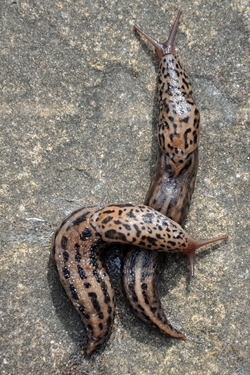Leopard slug
 There are approximately 30 species of slug in the UK, but just four of these cause most of the grief, costing approximately £8 million in damage a year to the vegetable crop sector alone – and that is using control methods!
There are approximately 30 species of slug in the UK, but just four of these cause most of the grief, costing approximately £8 million in damage a year to the vegetable crop sector alone – and that is using control methods!
There is a worry in the farming world that some of the main products for controlling slugs could be lost in the near future, so scientists have been busy working out the costs associated with losing effective methods of control.
For oilseed rape, around 59% of the total area is affected by slugs. Without pesticides, the calculated annual tonnage lost is estimated at 54,354 tonnes, costing the industry something like £18 million a year. For wheat, about 22% of the total area is affected by slugs, so without pesticides, the calculated annual tonnage lost is 53,280 tonnes, costing the industry an estimated £25.5 million per year.
On average a UK garden is home to over 20,000 slugs and it is estimated that an acre of farmland can support over 250,000 slugs. However, only around 5% of the slug population is above ground at any one time, with the other 95% spending their time underground, laying eggs and feeding on roots and seedlings.
Slugs move in rhythmic waves by contracting muscles on their underside. At the same time a layer of mucus is produced that helps to smooth the slugs path across the ground. This mucus is also used as the slugs navigation system, as slugs will find their way back to their tunnels and feeding sites by following their mucus trail.
A slug has two retractable pairs of tentacles. The upper pair of tentacles are called the optical tentacles and are the eyes of a slug. The optical tentacles have light-sensitive eyespots on the end and can be regrown if lost. These are also used for smell. The lower pair are two smaller tentacles and are used for feeling and tasting.
The mouth parts are below the tentacles and slugs eat using a radula, which is a tongue-like organ that is covered with, unbelievably, around 27,000 tiny tooth-like protrusions that are called denticles.
But it is not all bad news on the slug front! I am sad enough to have a favourite slug species – the leopard slug (Limax maximus). These guys don’t do much damage to living plants, as they eat mainly dead and rotting vegetation along with fungi, which helps recycle nutrients and fertilise the soil. But the really cool thing about leopard slugs is that they are omnivorous and will hunt down other slugs, overwhelming them with a top speed of 6 in/min. Please don’t titter now – that is frighteningly quick if you are the slug being chased!
The leopard slug is brown or grey, with brown or black spots/blotches; the front of body has marbled pattern of spots (never stripes); the back of body has up to three dark stripes on each side, which may be broken up into a line of dots. Every individual differs slightly in its pattern of black spots, while the underneath (sole) is completely white. It can grow up to an impressive 6 inches in length.
The leopard slug is also noted for its copulation habits. Two mating slugs will encircle each other before becoming physically entwined whilst hanging from a branch or other surface, literally suspending themselves in mid-air by utilising their mucus slime. They need the help of gravity to extend their large penises from openings in their heads. These appendages, which are the length of the slugs’ entire bodies, are coloured a pale blue and look as though they are made of plastic, making for an extraordinary spectacle.
After mating, both of a mated pair of slugs are able to lay eggs because these animals are hermaphroditic, which means the slug has male as well as female sexual organs.
So remember, should you come across a leopard slug in the garden – it’s “on our side”, helping to keep the other slugs under control, or at the very least, well exercised!
Peter Thompson
Advisory
Read more from Peter Thompson at his blog.

Download Peter Thompson's essential 26-page book, featuring beautiful photography and detailed profiles of Britain's wildlife
Download FREE >